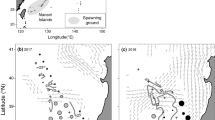Abstract
Japanese Spanish mackerel Scomberomorus niphonius is a pelagic, neritic species that occurs in the Yellow Sea in high commercial value. The spawning period of this fast-growing species is controlled by water temperature. Based on microstructural analysis of otoliths from 145 young-of-the-year (YoY) S. niphonius collected by trawl in 2017, 2018, and 2020, and the temporal variation in the spawning period in the northern Yellow Sea, and its relationship to water temperature were examined. We found that the spawning lasted from late April to late June but differed in year: in 2017 it occurred from April 23 to June 1 and peaked in early May, in 2018 it extended later from May 7 to June 29, and in 2020 from May 6 to June 22 and peaked later from late May to mid-June. The highest temperature in 2017 corresponds with the earliest end of the spawning period and a lower growing degree-day (GDD, °C·day) of 383 °C·day. In 2018, slower warming corresponds with a longer spawning period, and a GDD spawning period of 506 °C·day. Rapid warming in late 2020 corresponds with a spawning peak, and a GDD spawning temperature of 448 °C·day. Despite differences in spawning period, the water temperature when spawning commenced was 10–12 °C. Therefore, water temperature is the major determinant of the spawning period, affecting both the starting and the ending of spawning. This study improved our understanding of the spawning dynamics and environmental adaptation of S. niphonius, and how these might change in environments subject to increased warming.
Similar content being viewed by others
Data Availability Statement
Data generated or analyzed in this study are available from the corresponding author on reasonable request.
References
Campana S E. 1984. Interactive effects of age and environmental modifiers on the production of daily growth increments in otoliths of plainfin midshipman, Porichthys notatus. Fishery Bulletin), 82(1): 165–177.
Campana S E, Neilson J D. 1985. Microstructure of fish otoliths. Canadian Journal of Fisheries and Aquatic Sciences), 42(5): 1014–1032, https://doi.org/10.1139/f85-127.
Carscadden J, Nakashima B S, Frank K T. 1997. Effects of fish length and temperature on the timing of peak spawning in capelin (Mallotus villosus). Canadian Journal of Fisheries and Aquatic Sciences), 54(4): 781–787, https://doi.org/10.1139/cjfas-54-4-781.
Chiba M, Katou T, Kouno Y. 2008. Seasonal changes in age composition and growth of Spanish mackerel landed in Ehime Prefecture from Iyo-Nada of the Seto Inland Sea. Bulletin of the Japanese Society of Fisheries Oceanography), 72(3): 182–188. (in Japanese with English abstract)
Clark Barkalow S L, Brandenburg M A, Platania S P. 2020. Otoliths reveal spawning ecology and early life history of sympatric catostomids. North American Journal of Fisheries Management), 40(2): 415–426, https://doi.org/10.1002/nafm.10423.
Fincham J I, Rijnsdorp A D, Engelhard G H. 2013. Shifts in the timing of spawning in sole linked to warming sea temperatures. Journal of Sea Research), 75: 69–76, https://doi.org/10.1016/j.seares.2012.07.004.
Fujita T, Yamamoto M, Kono N et al. 2021. Temporal variations in hatch date and early survival of Japanese anchovy (Engraulis japonicus) in response to environmental factors in the central Seto Inland Sea, Japan. Fisheries Oceanography), 30(5): 527–541, https://doi.org/10.1111/fog.12535.
Hall A E, Vitale L, Kingsford M J. 2019. Planktonic larval duration, early growth, and the influence of dietary input on the otolith microstructure of Scolopsis bilineatus (Nemipteridae). Environmental Biology of Fishes), 102(4): 541–552, https://doi.org/10.1007/s10641-019-00852-z.
Houde E D. 2008. Emerging from Hjort’s Shadow. Journal of Northwest Atlantic Fishery Science), 41: 53–70, https://doi.org/10.2960/J.v41.m634.
Jiang Y Q, Fan Y N, Zheng C J et al. 2016. The effect of temperature on embryonic development of Scomberomorus niphonius. Journal of Zhejiang Ocean University (Natural Science), 35(4): 271–275, https://doi.org/10.3969/j.issn.1008-830X.2016.04.001. (in Chinese with English abstract)
Jiang Y Q, Zhang C, Ye Z J et al. 2020. Stock structure analysis of the Japanese Spanish mackerel Scomberomorus niphonius (Cuvier, 1832) Along the China coast based on truss network. Journal of Ocean University of China), 19(2): 446–452, https://doi.org/10.1007/s11802-020-4233-7.
Kitada S, Nakajima K, Hamasaki K. 2017. Population panmixia and demographic expansion of a highly piscivorous marine fish Scomberomorus niphonius. Journal of Fish Biology, 91(5): 1435–1448, https://doi.org/10.1111/jfb.13466.
Kono N, Takahashi M, Shima Y. 2014. Time of formation of incremental and discontinuous zones on sagittal otoliths of larval Japanese Spanish mackerel Scomberomorus niphonius. Nippon Suisan Gakkaishi, 80(1): 21–26, https://doi.org/10.2331/suisan.80.21.
Kupchik M J, Shaw R F. 2016. Age, growth, and recruitment of larval and early juvenile Atlantic croaker (Micropogonias undulatus), determined from analysis of otolith microstructure. Fishery Bulletin), 114(1): 18–33, https://doi.org/10.7755/fb.114.1.2.
Li M Y, Lin R C, Hong L Z. 1990. Composition of spawning stock and individual fecundity of Spanish mackerel in Sanmen Bay, Zhejiang. Journal of Oceanography in Taiwan Strait), 9(4): 366–374. (in Chinese with English abstract)
Ministry of Agriculture and Rural Affairs of the People’s Republic of China. 2020. China Fishery Statistical Yearbook. China Agriculture Press, Beijing. p. 38–40. (in Chinese)
Moltó V, Ospina-Alvarez A, Gatt M et al. 2020. A Bayesian approach to recover the theoretical temperature-dependent hatch date distribution from biased samples: the case of the common dolphinfish (Coryphaena hippurus), arXiv e-prints, arXiv:2004.01000, https://doi.org/10.48550/arXiv.2004.01000.
Mu X X, Zhang C, Zhang C L et al. 2018. The fisheries biology of the spawning stock of Scomberomorus niphonius in the Bohai and Yellow Seas. Journal of Fishery Sciences of China), 25(6): 1308–1316. (in Chinese with English abstract)
Munk P. 2007. Cross-frontal variation in growth rate and prey availability of larval North Sea cod Gadus morhua. Marine Ecology Progress Series, 334: 225–235, https://doi.org/10.3354/meps334225.
Murphy H M, Jenkins G P, Hamer P A et al. 2013. Interannual variation in larval abundance and growth in snapper Chrysophrys auratus (Sparidae) is related to prey availability and temperature. Marine Ecology Progress Series), 487: 151–162, https://doi.org/10.3354/meps10388.
Naimie C E, Blain C A, Lynch D R. 2001. Seasonal mean circulation in the yellow sea—a model-generated climatology. Continental Shelf Research), 21(6–7): 667–695.
Nakajima K, Kitada S, Yamazaki H et al. 2013. Ecological interactions between hatchery and wild fish: a case study based on the highly piscivorous Japanese Spanish mackerel. Aquaculture Environment Interactions), 3(3): 231–243, https://doi.org/10.3354/aei00065.
Neuheimer A B, Taggart C T. 2007. The growing degree-day and fish size-at-age: the overlooked metric. Canadian Journal of Fisheries and Aquatic Sciences), 64(2): 375–385, https://doi.org/10.1139/F07-003.
Park K A, Lee E Y, Chang E et al. 2015. Spatial and temporal variability of sea surface temperature and warming trends in the Yellow Sea. Journal of Marine Systems), 143: 24–38, https://doi.org/10.1016/j.jmarsys.2014.10.013.
Oh K H, Lee S, Song K M et al. 2013. The temporal and spatial variability of the Yellow Sea Cold Water Mass in the southeastern Yellow Sea, 2009–2011. Acta Oceanologica Sinica), 32: 1–10, https://doi.org/10.1007/s13131-013-0346-9.
Qiu S Y, Ye M Z. 1994. Study on the individual fecundity of mackrel in the Yellow Sea and Bohai Sea. Journal of Shanghai Fisheries University), 3(1–2): 21–26. (in Chinese with English abstract)
Qiu S Y, Ye M Z. 1996. Studies on the reproductive biology of Scomberomorus niphonius in the Yellow Sea and Bohai Sea. Oceanologia et Limnologia Sinica), 27(5): 463–471. (in Chinese with English abstract)
Shoji J, Maehara T, Aoyama M et al. 2001. Daily ration of Japanese Spanish mackerel Scomberomorus niphonius larvae. Fisheries Science), 67(2): 238–245, https://doi.org/10.1046/j.1444-2906.2001.00246.x.
Shoji J, Maehara T, Tanaka M. 1999. Diel vertical movement and feeding rhythm of Japanese Spanish mackerel larvae in the central Seto Inland Sea. Fisheries Science), 65(5): 726–730, https://doi.org/10.2331/fishsci.65.726.
Shoji J, Tanaka M. 2005. Daily ration and prey size of juvenile piscivore Japanese Spanish mackerel. Journal of Fish Biology), 67(4): 1107–1118, https://doi.org/10.1111/j.1095-8649.2005.00813.x.
Song C, Wang Y T, Liu Z L et al. 2016. Relationship between environmental factors and distribution of Scomberomorus niphonius eggs, larvae, and juveniles in Xiangshan Bay. Journal of Fishery Sciences of China), 23(5): 1197–1204. (in Chinese with English abstract)
Takasuka A, Oozeki Y, Aoki I. 2007. Optimal growth temperature hypothesis: why do anchovy flourish and sardine collapse or vice versa under the same ocean regime? Canadian Journal of Fisheries and Aquatic Sciences, 64(5): 768–776, https://doi.org/10.1139/f07-052.
Takasuka A, Oozeki Y, Aoki I et al. 2008. Growth effect on the otolith and somatic size relationship in Japanese anchovy and sardine larvae. Fisheries Science), 74(2): 308–313, https://doi.org/10.1111/j.1444-2906.2008.01519.x.
Wan R, Song P B, Li Z G et al. 2020. Distribution and environmental characteristics of the spawning grounds of Scomberomorus niphonius in the coastal waters of Yellow Sea, China. Chinese Journal of Applied Ecology), 31(1): 275–281, https://doi.org/10.13287/j.1001-9332.202001.032. (in Chinese with English abstract)
Wei S. 1980. The fishing seasons and grounds of the blue spotted mackerel, Scomberomorus Niphonius in the Yellow Sea and Bohai in relation to environmental factors. Transactions of Oceanology and Limnology), (2): 36–42, https://doi.org/10.13984/j.cnki.cn37-1141.1980.02.007. (in Chinese with English abstract)
Yu F, Ren Q, Diao X Y, Wei C J et al. 2022. The Sandwich Structure of the Southern Yellow Sea Cold Water Mass and Yellow Sea Warm Current. Frontiers in Marine Science), 8, https://doi.org/10.3389/fmars.2021.767850.
Yuan Y Y, Ye Z J, Liu Q et al. 2009. Fishery oceanography and spatial-temporal distribution of Scomberomorus niphonius in spring in Southern Yellow Sea. Oceanologia et Limnologia Sinica), 40(4): 506–510. (in Chinese with English abstract)
Zhang C, Ye Z J, Li Z et al. 2016. Population structure of Japanese Spanish mackerel Scomberomorus niphonius in the Bohai Sea, the Yellow Sea and the East China Sea: evidence from random forests based on otolith features. Fisheries Science), 82(2): 251–256, https://doi.org/10.1007/s12562-016-0968-x.
Zhang C, Ye Z J, Panhwar S K et al. 2013. Stock discrimination of the Japanese Spanish mackerel (Scomberomorus niphonius) based on the otolith shape analysis in the Yellow Sea and Bohai Sea. Journal of Applied Ichthyology), 29(2): 368–373, https://doi.org/10.1111/jai.12084.
Zhu Q H, Tian Y J, Zhang C et al. 2020. Daily age and growth of young-of-the-year Scomberomorus niphonius in the Yellow Sea and Bohai Sea based on otolith microstructure. Haiyang Xuebao), 42(2): 87–95, https://doi.org/10.3969/j.issn.0253-4193.2020.02.009. (in Chinese with English abstract)
Acknowledgment
We thank the investigators who participated in the seasonal trawl survey.
Author information
Authors and Affiliations
Corresponding author
Additional information
Supported by the National Natural Science Foundation of China (NSFC) (No. 41930534)
Rights and permissions
About this article
Cite this article
Pan, M., Zhang, C., Tian, Y. et al. Water temperature induced interannual variation in spawning of Japanese Spanish mackerel Scomberomorus niphonius in the northern Yellow Sea. J. Ocean. Limnol. 41, 1620–1627 (2023). https://doi.org/10.1007/s00343-022-2021-5
Received:
Accepted:
Published:
Issue Date:
DOI: https://doi.org/10.1007/s00343-022-2021-5




